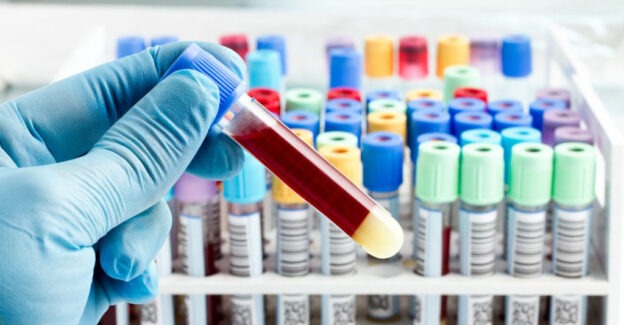Instructor
Elizabeth Maloney, MD
Education Co-Director, Invisible International
Description
Lyme disease can be difficult to diagnose on clinical grounds because of the symptoms and signs are generally nonspecific. This module discusses how clinicians may use serologic results in their diagnostic decision-making.
Note: It may be helpful to view Basic principles of diagnostic testing prior to participating in this activity.
Learning objectives
- Understand role of serology in diagnosing Lyme disease
- Understand the procedures for ELISA, Western blot and two-tier testing in Lyme disease
- Recognize the utility and limitations of serology in Lyme disease
This session, Serologic testing in Lyme disease, is approved for 1.0 enduring AAFP Prescribed credit.
AAFP Prescribed credit is accepted by the American Medical Association as equivalent to AMA PRA Category 1 credit(s)™ toward the AMA Physician’s Recognition Award. When applying for the AMA PRA, Prescribed credit earned must be reported as Prescribed, not as Category 1.
The AAFP has reviewed One Health Medical Education for a Changing Climate and deemed it acceptable for AAFP credit. Term of approval is from 01/02/2024 to 01/01/2025. Physicians should claim only the credit commensurate with the extent of their participation in the activity.
Evidence-based bibliography for further study
• Peterson MC, Holbrook JH, Hales D, Smith NL, Von Staker LV. Contributions of the History, Physical Examination, and Laboratory Investigation in Making Medical Diagnoses. West J Med 1992; 156:163-5.
• Markert RJ, Haist SA, Hillson HD, Rich EC, Sakowski HA, Maio AC. Comparative Value of Clinical Information in Making a Diagnosis. Med Gen Med 2004; 6(2):64.
• Groopman J. How Doctors Think. New York: Houghton Mifflin Company; 2007. 307p.
• Jaeschke R, Guyatt G, Sackett DL. Users’ guides to the medical literature, III: how to use an article about a diagnostic test, A: are the results of the study valid? JAMA. 1994; 271:389-391.
• Greenhalgh T. How to read a paper. Papers that Report Diagnostic or Screening Tests. BMJ. 1997; 315:540-543.
• Loong T. Understanding sensitivity and specificity with the right side of the brain. BMJ. 2003; 327(7417): 716-719.
• Pewsner D, Battaglia M, Minder C, Marx A, Bucher HC, Egger M. Ruling a diagnosis in or out with “SpPIn” and “SnNOut”: a note of caution. BMJ. 2004; 329(7459):209-213.
• Grimes DA, Schulz KF. Refining clinical diagnosis with likelihood ratios. Lancet. 2005 Apr 23- 29;365(9469):1500-1505.
• CDC staff. Recommendations for test performance and interpretation from the second national Conference on serologic diagnosis of Lyme disease. MMWR 1995; 44:590-591.
• Mead P, Petersen J, Hinckley A. Updated CDC Recommendation for Serologic Diagnosis of Lyme Disease. MMWR Morb Mortal Wkly Rep 2019;68:703.
• Coulter P, Lema C, Flayhart D, Linhardt AS, Aucott JN, Auwaerter PG, Dumler JS. Two-year evaluation of Borrelia burgdorferi culture and supplemental tests for definitive diagnosis of Lyme disease. J Clin Microbiol 2005; 43(10):5080-4. Erratum in: J Clin Microbiol. 2007;45(1):277.
• Regeniter A, Kuhle J, Mehling M, Möller H, Wurster U, Freidank H, Siede WH. A modern approach to CSF analysis: pathophysiology, clinical application, proof of concept and laboratory reporting. Clin Neurol Neurosurg 2009; 111(4):313-318.
• Magni R, Espina BH, Shah K, et al. Application of Nanotrap technology for high sensitivity measurement of urinary outer surface protein A carboxyl-terminus domain in early stage Lyme borreliosis. J Transl Med. 2015;13:346. Published 2015 Nov 4. doi:10.1186/s12967-015-0701-z
• Barbour AG. Isolation and cultivation of Lyme disease spirochetes. Yale J Biol Med 1984; 57:521- 525.
• de Koning J, Bosma RB, Hoogskamp-Korstanje JAA. Demonstration of spirochetes in patients with Lyme disease with a modified silver stain. J Med Microbiol 1987; 23:261-267.
• FDA data base of Lyme tests that have used the 510(k) process which does not require proof of clinical validity available at: http://www.accessdata.fda.gov/scripts/cdrh/cfdocs/cfPMN/pmn.cfm?start_search=1&Center= &Panel=MI&ProductCode=LSR&KNumber=&Model=&Applicant=&DeviceName=&Type=&ThirdP artyReviewed=&ClinicalTrials=&ExpeditedReview=&Decision=&DecisionDateFrom=&DecisionDa
teTo=07%2F17%2F2016&DeNovo=&IVDProducts=&CombinationProducts=&ZNumber=&PAGEN UM=10&SortColumn=DecisionDateDESC. Last accessed July 17, 2016.
• Engstrom SM, Shoop E, Johnson RC. Immunoblot interpretation criteria for serodiagnosis of early Lyme disease. J Clin Microbiol 1995; 33:419-427.
• Dressler F, Whalen JA; Reinhardt BN; Steere AC. Western blotting in the serodiagnosis of Lyme disease. J Infect Dis 1993; 167(2): 392-400.
• MMWR 2008; 57(02):42-45.
• Mogilyansky E, Loa CC, Adelson ME, Mordechai E, Tilton RC. Comparison of Western immunoblotting and the C6 Lyme antibody test for laboratory detection of Lyme disease. Clin Diagn Lab Immunol. 2004; 11(5):924-929.
• Tilton RC, Sand MN, Manak M. The western immunoblot for Lyme disease: determination of sensitivity, specificity, and interpretive criteria with use of commercially available performance panels. Clin Infect Dis 1997; 25 Suppl 1:S31-4.
• Bakken LL, Callister SM, Wand PJ, Schell RF. Intralaboratory comparison of test results for detection of Lyme disease by 516 participants in the Wisconsin State Laboratory of Hygiene/College of American Pathologists Proficiency Testing Program. J Clin Microbiol. 1997 Mar; 35(3):537-543.
• Lange R, Seyyedi S. Evidence of a Lyme borreliosis infection from the viewpoint of laboratory medicine. Int J Med Microbiol. 2002; 291 Suppl 33:120-124.
• Marangoni A, Sparacino M, Cavrini F, Storni E, Mondardini V, Sambri V, Cevenini R. Comparative evaluation of three different ELISA methods for the diagnosis of early culture-confirmed Lyme disease in Italy. J Med Microbiol. 2005; 54(Pt 4):361-367.
• Reed K. Laboratory Testing for Lyme Disease: Possibilities and Practicalities J Clin Microbiol. 2002 February; 40(2):319-324.
• Binnicker MJ, Jespersen DJ, Harring JA, Rollins LO, Bryant SC, Beito EM. Evaluation of two commercial systems for automated processing, reading, and interpretation of Lyme borreliosis Western blots. J Clin Microbiol 2008; 46(7):2216-2221.
• Ang CW, Notermans DW, Hommes M, Simoons-Smit AM, Herremans T. Large differences between test strategies for the detection of anti-Borrelia antibodies are revealed by comparing eight ELISAs and five immunoblots. Eur J Clin Microbiol Infect Dis 2011; 30(8):1027-1032.
• Oksi J, Uksila J, Marjamäki M, Nikoskelainen J, Viljanen MK. Antibodies against whole sonicated Borrelia burgdorferi spirochetes, 41-kilodalton flagellin, and P39 protein in patients with PCR- or culture-proven late Lyme borreliosis. J Clin Microbiol. 1995; 33(9):2260-2264.
• Ledue TB, Collins MF, Craig WY. New laboratory guidelines for serologic diagnosis of Lyme disease: evaluation of the two-test protocol. J Clin Microbiol 1996; 34:2343-2350.
• Trevejo RT, Krause PJ, Sikand VK, Schriefer ME, Ryan R, Lepore T, Porter W, Dennis DT. Evaluation of two-test serodiagnostic method for early Lyme disease in clinical practice. J Infect Dis 1999; 179:931-938.
• Wang G, Van Dam AP, Schwartz I, Dankert J. Molecular Typing of Borrelia burgdorferi Sensu Lato: Taxonomic, Epidemiological, and Clinical Implications. Clin Microbio Reviews 1999; 12(4):633–653.
• Goossens HA, van den Bogaard AE, Nohlmans MK. Evaluation of fifteen commercially available serological tests for diagnosis of Lyme borreliosis. Eur J Clin Microbiol Infect Dis 1999; 18(8):551- 560.
• van Dam AP. Recent advances in the diagnosis of Lyme disease. Expert Rev Mol Diagn 2001; 1(4):413-427.
• Embers ME, Barthold SW, Borda JT, et al. Persistence of Borrelia burgdorferi in rhesus macaques following antibiotic treatment of disseminated infection.PLoS One. 2012; 7(1):e29914. Epub 2012 Jan 11. Erratum in: PLoS One. 2012;7 Embers ME.
• Bacon RM, Bickerstaff BJ, Schreifer ME, Gilmore RD, Philipp MT, Steere AC, Wormser GB, Marques AR, Johnson BJ. Serodiagnosis of Lyme Disease by Kinetic Enzyme-Linked Immunosorbent Assay Using Recombinant VlsE1 or Peptide Antigens of Borrelia burgdorferi compared with 2-Tiered Testing Using Whole Cell Lysates. J Infect Dis 2003; 187:1187-1199.
• Liang FT, Steere AC, Marques AR, Johnson BJ, Miller JN, Philipp MT. Sensitive and specific serodiagnosis of Lyme disease by enzyme-linked immunosorbent assay with a peptide based on an immunodominant onserved region of Borrelia burgdorferi vlsE. J Clin Microbiol. 1999; 37(12):3990-3996.
• Göttner G, Schulte-Spechtel U, Wilske B. Heterogeneity of the immunodominant surface protein VlsE among the three genospecies of Borrelia burgdorferi pathogenic for humans. Int J Med Microbiol 2004; 293 Suppl 37:172-173.
• Gomes-Solecki MJ, Meirelles L, Glass J, Dattwyler RJ. Epitope length, genospecies dependency, and serum panel effect in the IR6 enzyme-linked immunosorbent assay for detection of antibodies to Borrelia burgdorferi. Clin Vaccine Immunol. 2007; 14(7):875-879.
• Sillanpaa H, Lahdenne P, Sarvas H et al. Immune responses to borrelial VlsE IR6 peptide variants. Int J Med Microbiol 2007; 297:45-52.
• Tjernberg I, Sillanpää H, Seppälä I, Eliasson I, Forsberg P, Lahdenne P. Antibody responses to borrelia IR(6) peptide variants and the C6 peptide in Swedish patients with erythema migrans. Int J Med Microbiol. 2009; 299(6):439-446.
• Hauser U, Krahl H, Peters H, Fingerle V, Wilske B. Impact of strain heterogeneity on Lyme disease serology in Europe: comparison of enzyme-linked immunosorbent assays using different species of Borrelia burgdorferi sensu lato. J Clin Microbiol 1998; 36(2):427-436.
• Fawcett PT, Rosé CD, Gibney KM, Doughty RA. Comparison of immunodot and western blot assays for diagnosing Lyme borreliosis. Clin Diagn Lab Immunol 1998; 5(4):503-506.
• Wilske B, Habermann C, Fingerle V, Hillenbrand B, Jauris-Heipke S, Lehnert G, Pradel I, Rössler D, Schulte-Spechtel U. An improved recombinant IgG immunoblot for serodiagnosis of Lyme borreliosis. Med Microbiol Immunol 1999; 188(3):139-144.
• Trevejo RT, Krause PJ, Schriefer ME, Dennis DT. Evaluation of a two-test serodiagnostic method for community assessment of Lyme disease in an endemic area. Am J Trop Med Hyg. 2001; 65(5):563-566.
• Craft JE, Fischer DK, Shimamoto GT, Steere AC. Antigens of Borrelia burgdorferi recognized during Lyme disease. Appearance of a new immunoglobulin M response and expansion of the immunoglobulin G response late in the illness. J Clin Invest. 1986; 78(4):934-939.
• Aguero-Rosenfeld ME, Nowakowski J, Bittker S, Cooper D, Nadelman RB, Wormser GP. Evolution of the serologic response to Borrelia burgdorferi in treated patients with culture-confirmed erythema migrans. J Clin Microbiol. 1996;34(1):1-9.
• Fallon BA, Keilp JG, Corbera KM, et al. A randomized, placebo-controlled trial of repeated IV antibiotic therapy for Lyme encephalopathy. Neurology 2008; 70:992-1003.
• Steere AC, McHugh G, Damle N, Sikand VK. Prospective study of serologic tests for Lyme disease. Clin Infect Dis. 2008; 47(2):188-195.
• Dattwyler RJ, Volkman DJ, Luft BJ, Halperin JJ, Thomas J, Golightly MG. Seronegative late Lyme borreliosis: dissociation of Borrelia burgdorferi specific T and B lymphocyte responses following early antibiotic therapy. N Engl J Med 1988; 319:1441-1446.
• Keller TL, Halperin JJ, Whitman M. PCR detection of Borrelia burgdorferi DNA in cerebrospinal fluid of Lyme neuroborreliosis patients. Neurology. 1992;42(1):32-42. doi:10.1212/wnl.42.1.32
• Logigian EL, Kaplan RF, Steere AC. Successful treatment of Lyme encephalopathy with intravenous ceftriaxone. J Infect Dis 1999, 180(2), 377-383.
• Lawrence C, Lipton RB, Lowy FD, Coyle PK. Seronegative chronic relapsing neuroborreliosis. Eur Neurol 1995; 35:113-117.
• Schutzer SE, Coyle PK, Belman AL, Golightly MG, Drulle J. Sequestration of antibody to Borrelia burgdorferi in immune complexes in seronegative Lyme disease. Lancet 1990; 335(8685):312- 315.
• Hunfeld KP, Stanek G, Straube E, Hagedorn HJ, Schörner C, Mühlschlegel F, Brade V. Quality of Lyme disease serology. Lessons from the German Proficiency Testing Program 1999-2001. A preliminary report. Wien Klin Wochenschr. 2002; 114(13-14):591-600.
• Hilton E, Devoti J, Sood S. Recommendation to include OspA and OspB in the new immunoblotting criteria for serodiagnosis of Lyme disease. J Clin Microbiol 1996; 34(6):1353- 1354. Erratum in: J Clin Microbiol 1997;35(10):2713.
• CSTE surveillance case definition available at: http://www.cdc.gov/osels/ph_surveillance/nndss/casedef/lyme_disease_current.htm. Last accessed on Aug 11, 2016.
• Sivak SL, Aguero-Rosenfeld ME, Nowakowski J, Nadelman RB, Wormser GP. Accuracy of IgM immunoblotting to confirm the clinical diagnosis of early Lyme disease. Arch Intern Med. 1996; 156(18):2105-2109.
• Ma B, Christen B, Leung D, Vigo-Pelfrey C. Serodiagnosis of Lyme borreliosis by western immunoblot: reactivity of various significant antibodies against Borrelia burgdorferi. J Clin Microbiol. 1992; 30(2):370-376.
• Wutte N, Archelos J, Crowe BA, Zenz W, Daghofer E, Fazekas F, Aberer E. Laboratory diagnosis of Lyme neuroborreliosis is influenced by the test used: comparison of two ELISAs, immunoblot and CXCL13 testing. J Neurol Sci. 2014; 347(1-2):96-103. doi: 10.1016/j.jns.2014.09.027
• Kannian P, McHugh G, Johnson B, Bacon R, Glickstein L, Steere A. Antibody Responses to Borrelia burgdorferi in Patients With Antibiotic-Refractory, Antibiotic-Responsive, or Non– Antibiotic-Treated Lyme Arthritis. Arthritis Rheumatism 2007; 56(12):4216-4225.


